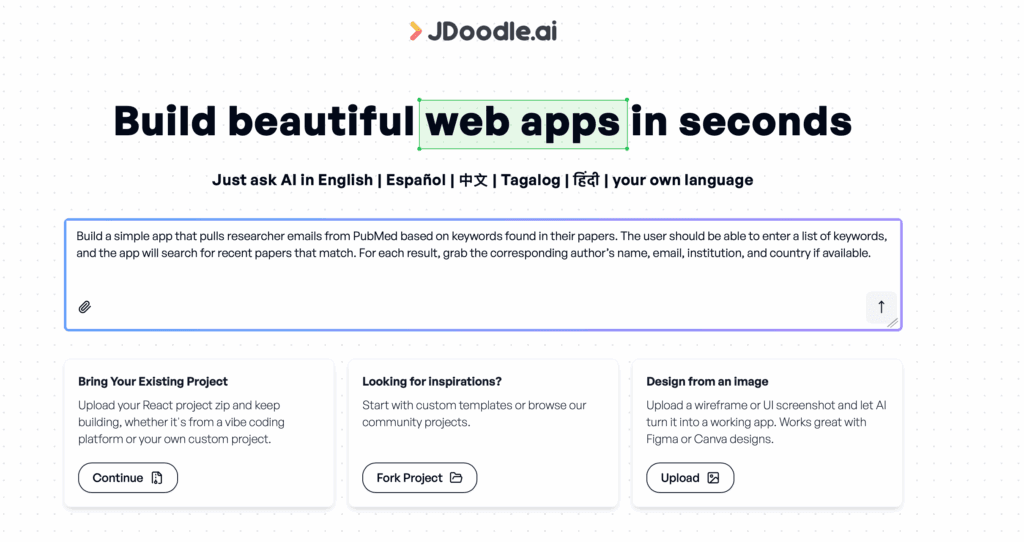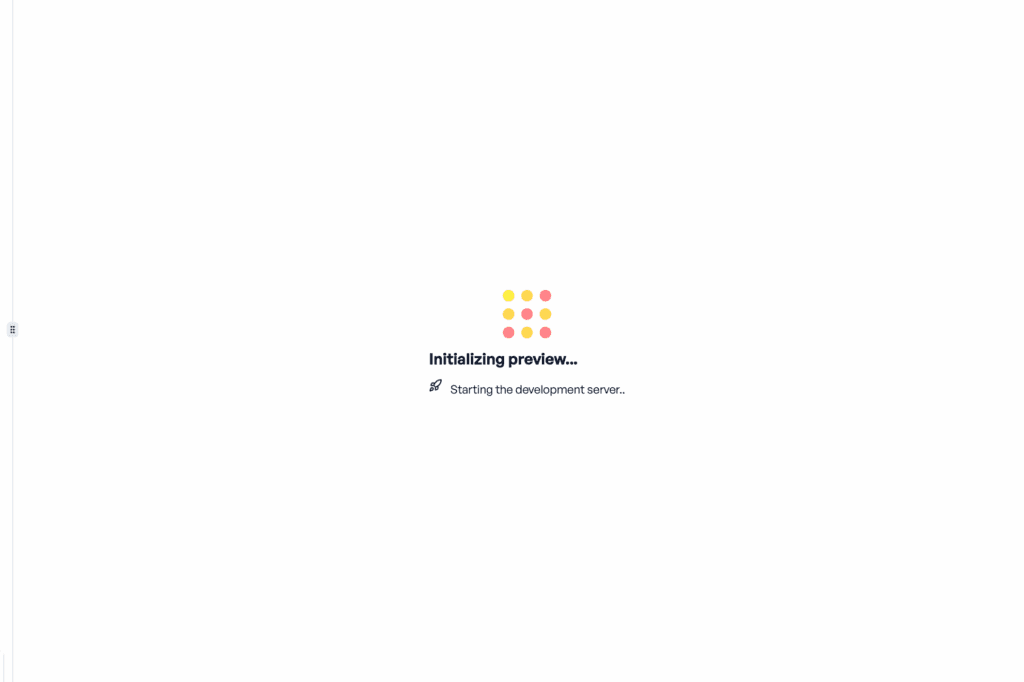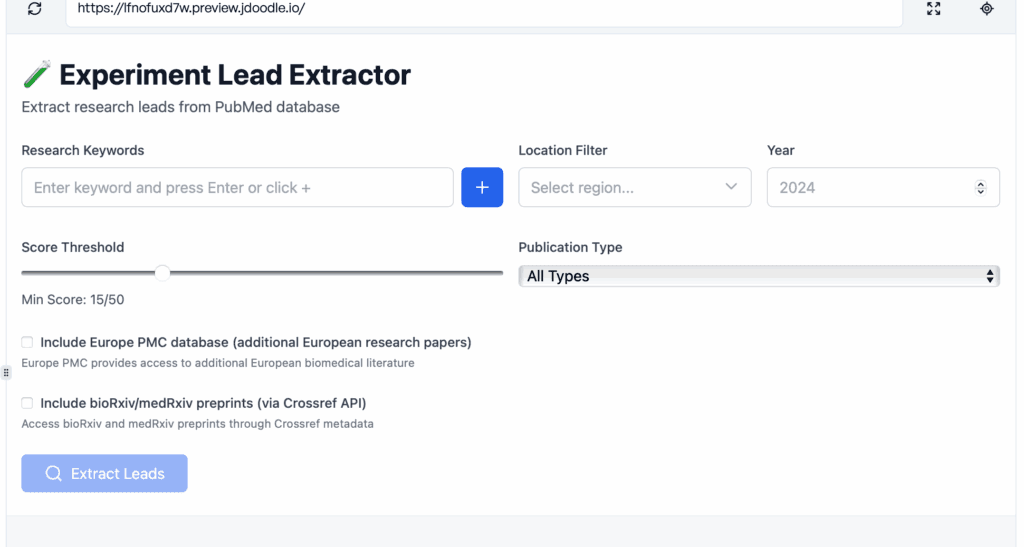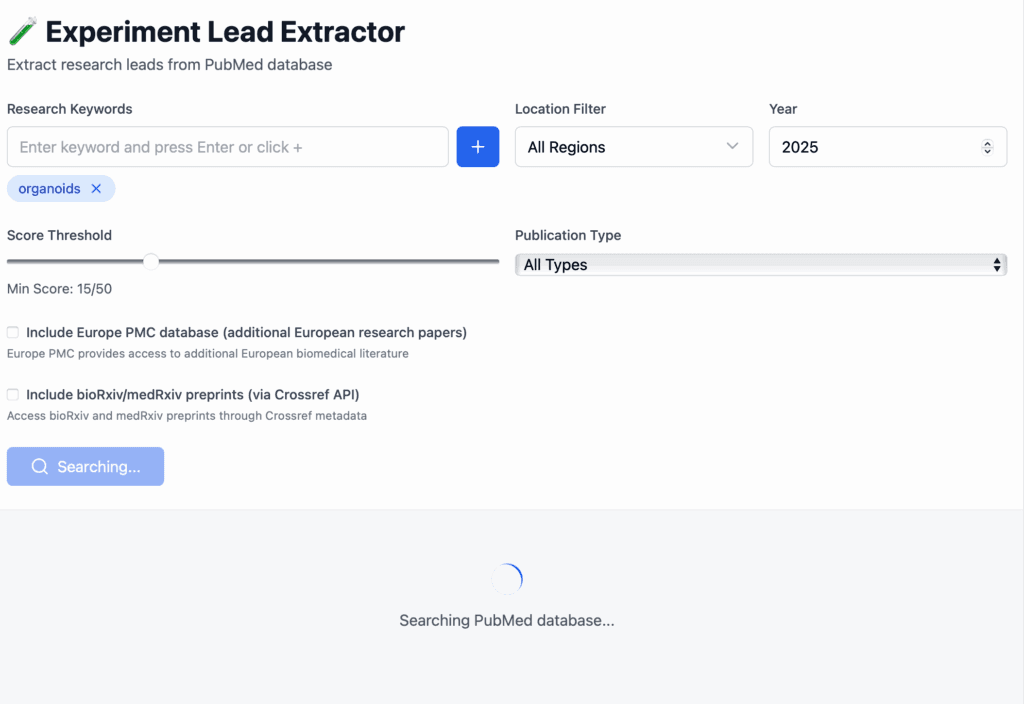How I built a researcher discovery tool without writing a single line of code
I was working on a research project and needed to connect with other researchers. The standard approach meant spending hours manually searching through PubMed, copying and pasting author details into spreadsheets, then playing detective to track down email addresses. LinkedIn was basically useless. Most researchers either aren’t on there, or their profiles are completely outdated with work from three years ago that doesn’t match their current research focus.
I had specific problems that needed solving:
- I was wasting hours on manual work that could obviously be automated
- I was limiting myself to one database at a time when I should be searching multiple sources simultaneously
- Most frustrating of all: what’s the point of identifying relevant researchers if you can’t actually reach them because you don’t have their contact information?
So I decided to build an app that would handle all of this automatically. That’s when I went to JDoodle.ai with a clear goal: build an Academic Lead Finder that would eliminate this tedious manual process entirely. Instead of spending my time on repetitive tasks, I wanted to focus on the actual research and meaningful outreach. The solution I built became my go-to research tool for connecting with the right people in my field.
The web app works like a research assistant that hits multiple databases simultaneously PubMed, Europe PMC, bioRxiv, and medRxiv. It pulls researcher contact info including emails, institutions, and ORCID IDs, then ranks papers by relevance so the most useful results appear first. Everything exports to CSV for easy spreadsheet management. It’s essentially a specialised search engine for finding researchers, but built specifically for my workflow instead of trying to be everything to everyone.
I am writing this because if you’re running a business that needs to connect with experts, researchers, or thought leaders in any field, this same approach can work for you. Think about it: the ability to quickly build custom tools that solve your specific business problems is a total game changer.
The JDoodle.ai experience
Here’s where it gets really cool, I didn’t write a single line of code from scratch. With JDoodle.ai, I just described what I wanted in plain English. The platform took care of all the backend complexity – API authentication, data formatting, error handling, responsive design. I focused on describing the workflow I wanted: search these databases, extract this information, display results this way, export to CSV.
Instead of learning how APIs work together, I just told the system which data sources I needed and how they should connect. JDoodle.ai figured out the technical details and built a working app that did exactly what I described.
I search for “machine learning applications” and the app hits all the databases simultaneously – PubMed, Europe PMC, bioRxiv, medRxiv. Then it applies whatever filters I’ve set: recent papers only, specific regions, certain publication types.
For each author it finds, the app runs through multiple sources trying to locate contact information. It checks PubMed’s author data first, then cross-references ORCID profiles, and makes educated guesses based on institutional affiliations when direct contact info isn’t available. The relevance scoring looks at how well papers match my search terms – checking titles, abstracts, and how recent the publication is. Everything gets ranked so the most relevant results appear at the top.
Results show up in a sortable table where I can organize by author, institution, publication date, or relevance score. When I’m satisfied with what I’ve found, one click exports everything to CSV format ready for my spreadsheets.
How it actually works
The whole process that used to take me hours of manual work now happens in a few minutes with much more comprehensive results than I could gather manually.

Step 1: Starting with a simple prompt
I went to JDoodle.ai and in the main text box, I typed the prompt in simple English. Perfect for someone like me who had an idea but didn’t want to spend weeks coding.

Step 2: JDoodle.ai gets to work
After hitting enter, I saw the “Initialising preview…” screen with the colorful loading dots and “Starting the development server…” message. This took maybe 30-60 seconds while JDoodle.ai processed my request and started building the app.

Step 3: First version appears
The initial app appeared with a clean interface titled “Experiment Lead Extractor”. It had:
- A keyword input field with “Enter keyword and press Enter or click +”
- Location filter dropdown (set to “All Regions”)
- Year selector (defaulted to 2024)
- Score threshold slider
- Publication type dropdown
- Checkboxes for Europe PMC and bioRxiv/medRxiv databases
- A blue “Extract Leads” button
Step 4: Adding more data sources and final touches
I wanted to expand beyond just PubMed, so I went back and refined my prompts: “Connect to Europe PMC database for additional European research papers” and “Add bioRxiv and medRxiv preprint servers via Crossref API” (Crossref is like a registry that stores metadata for scholarly content so I can search their papers programmatically without scraping each site.)

Step 5: Testing and iterating
I tested it with “organoids” as a keyword and it worked.

Within about an hour of iterative prompting and testing, I had a fully functional research lead finder that:
- Searches multiple academic databases simultaneously
- Extracts contact information and paper details
- Scores results by relevance
- Allows filtering by location, year, and publication type
- Exports results to CSV
- Has a clean, professional interface
My first prompt was basic but clear about the core functionality I wanted. Each improvement was just another plain English prompt. No need to understand APIs or database connections (though the API documentation is super easy to follow). I tried the app after each major change to make sure it still worked.
Even though we used no-code, there’s still some cool tech happening under the hood. There’s a React frontend with Tailwind CSS styling, API orchestration handling multiple data sources, smart data parsing from XML, JSON, and various formats, CORS proxy magic to avoid browser security issues, and real-time relevance calculation using keyword matching algorithms. The beauty is that JDoodle.ai handled all the complex setup.
What makes this special
The real takeaway here isn’t just about my research tool. It’s about what becomes possible when you can quickly build custom solutions for your business needs. Want to automate a tedious process your team does every week? Build it. Have a crazy idea that could give you a competitive edge? Build it and test it in an afternoon.
This approach works for way more than just academic research. Whether you’re hunting for industry experts, looking for potential collaborators, or trying to identify thought leaders in your field, you can search for anything “artificial intelligence,” “renewable energy,” “climate change” and get comprehensive results in minutes instead of hours.
The bigger point here is that building useful tools doesn’t require months of development anymore. In 2025, the gap between “I wish this existed” and “I actually built this” has pretty much disappeared. There are several platforms that make this kind of rapid development possible. Bubble works like a complete development environment where you can build full web applications with databases, user management, payment processing, everything you’d need for a real product. Actual companies have built entire businesses on Bubble.
Retool excels at internal business tools. Need a custom dashboard? Want something that connects to your existing databases and APIs? Retool makes it simple to create professional admin panels and business tools that actually function properly. Webflow handles anything where visual design matters. Company websites, landing pages, marketing sites, it’s like having a professional designer and developer working together. And Zapier connects everything, acting like digital duct tape between all your tools. Form submission triggers email list addition, creates project tasks, sends Slack notifications..all automatically.
Now, what I built is still a prototype. It’s not perfect, and there are definitely improvements I’d make for a production version. But here’s what matters: it solved my problem. I actually used it for real research projects and it saved me hours of manual work each time.
Sometimes you don’t need perfection, you just need something that works well enough to handle your immediate problem. Who knows, your “wouldn’t it be cool if…” moment might be just a few clicks away.
Also checkout these top 7 low-code/no-code solutions for SMEs
Keep up to date with our stories on LinkedIn, Twitter, Facebook and Instagram.


